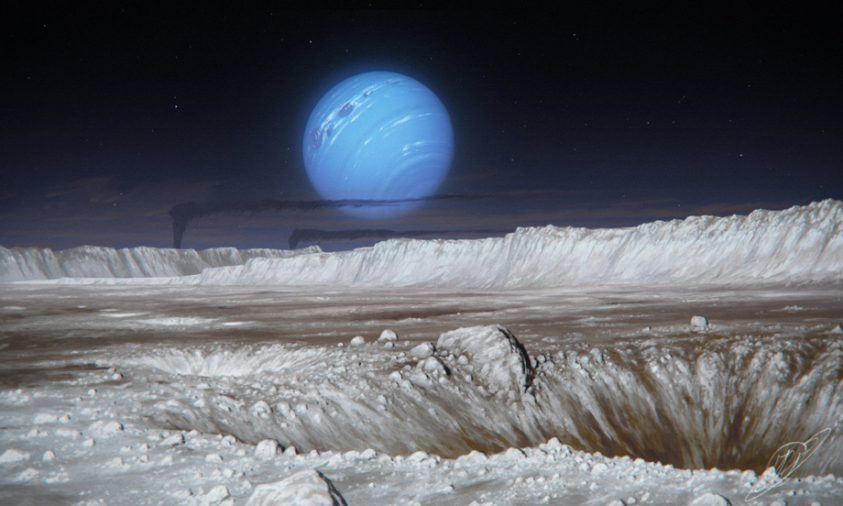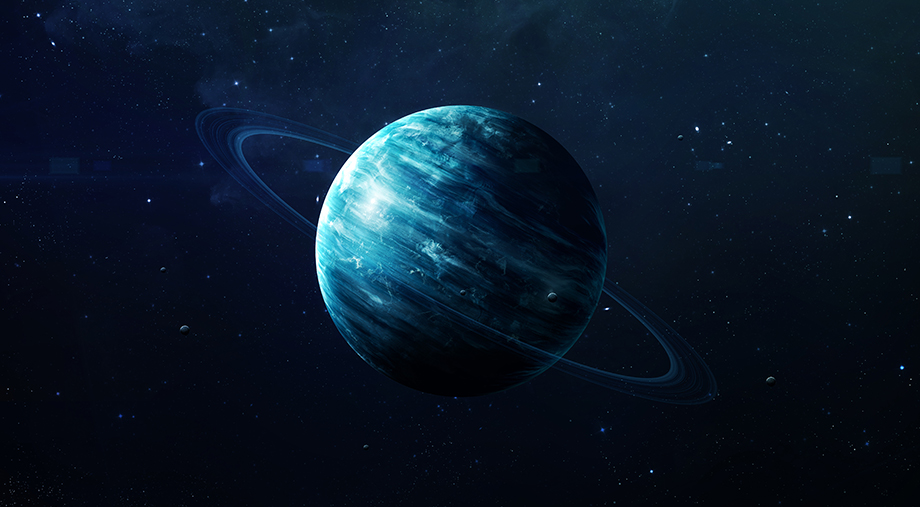Neptune is the most distant planet in the solar system, at least for now. It has already lost this title once in the past, and we cannot rule out that this will happen again in the future.
In any case, given the enormous distance between us and Neptune, it is a very difficult target to study. However, scientists still managed to uncover some of the eighth planet’s secrets. Today, we will talk about exactly how this was done.
Opening at the tip of the pen
Unlike all the other planets in the solar system, Neptune simply cannot be seen in the sky with the naked eye. Therefore, observing it became possible only after the invention of the telescope. The first person to see Neptune was Galileo Galilei. In the sketches he made, dated December 28, 1612 and January 27, 1613, the scientist indicated a small asterisk. According to calculations made in our time, it was Neptune that Galileo noticed. Unfortunately, his telescope was too weak for him to see the planet’s disk.
However, some researchers argue that Galileo at least suspected that the body he observed was not an ordinary star. Even if this was the case, the Italian astronomer did not leave any specific notes on this matter.
Neptune was subsequently observed several times by astronomers, but no one recognized it as a planet. Its official discovery became possible only thanks to an astronomical detective story which unfolded in the first half of the 19th century.

Photo: @Libroantiguo
The fact is that after the discovery of Uranus, scientists noticed that it was moving in its orbit slightly differently than it should have according to the law of universal gravitation. It was assumed that this was the result of the influence of gravity from an as-yet-undiscovered eighth planet. As a result, a kind of race began between astronomers from France and England for the right to be the first to find the gravitational “troublemaker.”
France won this competition. The French mathematician Urbain Le Verrier made calculations that made it possible to determine the approximate position of the unknown planet. He then sent his work to astronomer Johann Halle of the Berlin Observatory. Halle received the letter from Le Verrier on September 23, 1846, after which he immediately began observations. With the help of student Heinrich d’Arre, literally that very night, he found an unknown planet very close to the place indicated by Le Verrier. This discovery became one of the greatest scientific triumphs of the 19th century.
As in the case of Uranus, a controversy quickly erupted over what the newly discovered planet should be called. Johann Halle favored the name Janus, but Urbanat Le Verrier didn’t. Claiming that he had the right to name the discovered planet, Le Verrier initially proposed the name “Neptune”. Then the mathematician changed his mind and said that it should be named after him – Le Verrier. But this option was not at all amenable to astronomers outside of France. The name “Ocean” was also considered, but it, too, did not get much support. In the end, the name Neptune was settled on.
164 years per revolution around the Sun
From the very beginning, the study of Neptune was seriously hampered by its tremendous 4.5 billion km distance from Earth. It takes Neptune 164 years to complete one revolution around the Sun. As a matter of fact, in the time that has passed since the discovery of the planet, according to its calendar, only a little more than a single Earth year has passed.

Image: George Fergus
Nevertheless, albeit bit by bit, astronomers gradually gathered information about the planet. It turned out that Neptune is slightly smaller in size than Uranus, but larger in mass. Soon after the planet’s discovery, astronomers managed to discover that it has a fairly large moon, which was designated Triton. The discovery of Uranus’s next moon would have to wait more than a century. We now know that all of Neptune’s other moons are extremely small, with their combined mass totalling only half a percent of Triton’s mass.
This is due to the fact that Triton is a “non-native” moon of Neptune. It moves around it in a retrograde orbit, which is strongly inclined to the planes of the planet’s ecliptic and equator. This circumstance suggests that Triton is a captured object. Its orbit most likely initially lay in the Kuiper belt. But at some point, Neptune’s gravity captured Triton and transferred it into a permanent orbit around the planet.

Image: @VitkusJustinas
Such an event would almost certainly destroy the orbits of the planet’s pre-existing moon. Neptune apparently once possessed a family of large moons comparable to those of Uranus, but Triton’s capture led to their collision with each other and complete destruction. In the end, only a few tiny moons remained from them.
Another important discovery was made in 1984, when astronomers realized that Neptune has rings. They are, however, quite narrow and dull, and are inferior in the complexity of their structure not only to the rings of Saturn, but even to those of Uranus.

At the same time, they also have a unique feature. One of Neptune’s rings contains several arcs that exist separately and do not merge into a contiguous structure. Astronomers explain this phenomenon by the fact that the substance of the arcs is kept in balance by Neptune’s smaller moons, acting as peculiar “shepherds.”
Meeting at the edge of the solar system
Like Uranus, Neptune has only been visited by one spacecraft in its entire history of exploration. This happened in 1989, when the legendary Voyager 2 probe flew near the planet. By that time, Voyager 2’s journey had already lasted twelve years, and the probe was still functioning even though it had been intended to last for only four. In this regard, it is interesting to note that NASA itself initially estimated that there was only a 40% chance that Voyager 2 would remain operational by the time it encountered Neptune. Fortunately, the device put all its sceptics to shame.
The historic meeting at the edge of the solar system took place on August 25, 1989. Voyager 2 flew at an altitude of 4950 km above the planet’s North Pole.

Photo: NASA
Visually, Neptune turned out to be much more beautiful than Uranus. It even had a large atmospheric storm in its atmosphere, which, by analogy with the Great Red Spot of Jupiter, was called the Great Dark Spot. Its diameter exceeded the diameter of the Earth. However, the Great Dark Spot turned out to be not as long-lived as its famous brother, and it disappeared by 1994. Voyager 2 was also able to record hurricane-force winds blowing in the planet’s atmosphere. Their speeds reached 600 m/s, which is a record for the Solar System.

Photo: NASA
In its internal structure, Neptune turned out to be similar to Uranus. The planet’s atmosphere consists of hydrogen and helium, with an icy mantle of water, methane, and ammonia beneath, and a rocky core at the very center. Therefore, like Uranus, Neptune is now classified as an ice giant.
Neptune also resembles Uranus in its magnetic field. It is inclined by 47° relative to the planet’s rotation axis and is asymmetrical, with its center is displaced by approximately 0.55 of the planet’s radius from its center. Before Voyager 2 arrived at Neptune, scientists believed that Uranus’s displaced magnetosphere was the result of an anomalous rotation. However, it has now become clear that this is a common feature of the ice giants, apparently associated with the peculiarities of their internal structure.
Voyager 2 photographed Neptune’s rings and found several of its previously unknown moons. But the main star of the flyby was Triton, which turned out to be very active. A number of nitrogen geysers were discovered on its surface, with heights reaching 8 km. Voyager 2 even managed to photograph the nitrogen clouds that formed in Triton’s extremely thin atmosphere.

Photo: NASA
In addition, bodies resembling frozen lakes with shores in the form of stepped terraces were discovered around Triton’s equator. These “steps” can reach a kilometer in height. It is now believed that after Triton was captured by Neptune’s gravity, its orbit gradually changed. Tidal interaction with the planet led to the fact that the moon’s surface melted several times and then solidified, which led to the formation of these structures.
Moreover, subsequent computer simulations performed using Voyager 2 data pointed to a rather intriguing possibility. There may be a whole ocean in Triton’s depths, which may well have conditions conducive to supporting life.

Photo: NASA
Analysis of Voyager 2 data also resolved the mystery of Planet X, a hypothetical celestial body influencing the orbit of Uranus. The search for it at one time led to the discovery first of Neptune, and then, when its mass was not enough to explain all the recorded deviations, of Pluto. But Voyager 2 measurements showed that Neptune’s mass was originally determined with an error roughly equal to the mass of Mars. When it was taken into account, all apparent inconsistencies in the orbit of Uranus disappeared, and with them the need for Planet X in its traditional sense.
Current research on Neptune
To this day, Voyager 2 remains the only Earth mission to explore Neptune at close range. Fortunately, the introduction of new, more powerful telescopes has made it possible for astronomers to track the planet’s weather cycles. To scientists’ surprise, it turned out that despite its very large distance from the Sun, the state of the cloud cover on Neptune is directly related to the cycles of solar activity. The more active our star, the brighter the clouds on the eighth planet, as well as the opposite.
Researchers have also managed to find several previously unknown moons of Neptune. All of them turned out to be very small.

Photo: NASA
In 2006, Neptune was designated as the final planet in the solar system for the first time in 76 years. This happened after the famous meeting of the International Astronomical Union, which decided to “demote” Pluto and deprive it of its planet status.
As in the case of Uranus, the organization of a new space mission to Neptune is hampered by the lack of necessary funding, insufficient (in the case of NASA) reserves of the plutonium-238 required to supply it with energy, as well as the tremendously long flight time, which is measured in decades.
However, various teams of researchers have made several attempts to get the go-ahead for such a flight. One of them was developed by the team that once built the New Horizons probe. Their project involved the construction of an automatic station, reminiscent of the Cassini apparatus, which would be placed in a permanent orbit around Neptune. Alas, NASA was never interested in this proposal.
A simpler mission called Trident participated in the recent selection for the Discovery program. It involved sending a probe that would study Neptune and Triton from a flyby trajectory. If approved, Trident’s visit to the eighth planet would take place in 2038. Alas, this project also did not receive the green light.

Photo: L. M. Prockter al./LPSC/USRA/JPL/SwRI
It is possible that the next earthly messenger to meet Neptune will be built in China. Scientists there are currently developing a project for the Interstellar Express mission. It involves sending two probes to study Neptune’s heliosphere. The flight plan calls for one of them to fly by the planet in 2038, but it is currently unknown whether the Chinese leadership will approve the project.
In any case, we can only hope that sooner or later, some space agency will carry out a mission to Neptune and we will see it again. Let’s hope that this happens before the planet makes another revolution around the Sun.





